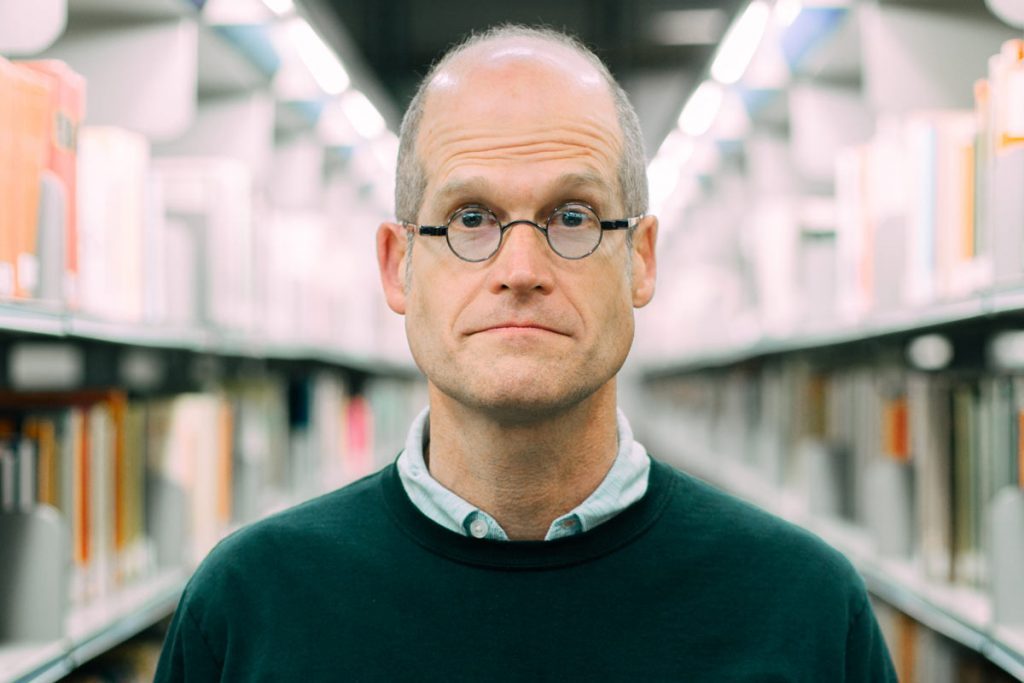“My own library is my life” : 3 questions to Chris Ware
On the occasion of the exhibition dedicated to him from June to October 2022, the Bpi asked three questions to the American comic book author Chris Ware.

You specially created the poster design for the exhibition. Can you tell us about your inspiration, your thought process and your intention in this creation?
C.W. : I tried to honor Renzo Piano’s description of his plan for the Pompidou as a “big urban toy,” which I hope some Parisians will recognize. It’s sort of how the building appeared to me when I first came across it pictured in a book at age twelve. I’d never seen, or thought of, anything like it before, growing up middle class in a middle-sized town in the middle of the United States. I spent a fair amount of time in the school library reading outdated astronomy and architecture books and, really, anything I could get my hands on simply to avoid having to go to gym class.
Fortunately, this predilection has continued into my adult life — architecture, books and memory all being aspects of the same thing, at least if you’re an insane cartoonist.
Heureusement, cette prédilection s’est poursuivie dans ma vie d’adulte, l’architecture, les livres et la mémoire étant tous des aspects de la même chose, du moins si vous êtes un dessinateur fou.
How would you define the difference between France and the United States in their way of considering the 9th art? Can you give us examples?
C.W. : For starters, in France it’s called it an “art.” Americans call it “trash,” and generally file it accordingly. On one hand, there’s a certain advantage to this viewing of comics as a low-level effort, since it keeps American cartoonists humble and the viewer’s eyes open (i.e. viewers who don’t understand a painting might simply blame their ignorance of art history, whereas readers who don’t understand a comic strip just figure the cartoonist is an idiot.)
I studied painting and sculpture in university, but as far as I’m concerned, comics more accurately reflect the way we remember and order the world, with everything accessible all at once in brief bursts of distilled picture-memories layered into a crafted story-shape that’s ultimately bigger on the inside than the outside. The language of comics grows out of reading pictures, not just looking at them, comic strip images being translucent abbreviations of experience in the same way that words condense the essence of something into an idea. It’s up to the cartoonist to take this seed of reduction and turn it back around into something that blossoms into an art that seems to happen on the very page itself — and one that’s as complex, confusing and, hopefully, as moving and emotional as real life.
You are, as you say yourself, a full “book artist”… What does the fact of being exhibited in a library like the Bpi inspire in you?
C.W. : A book, like a human being, has 1) a spine, 2) is (again) bigger on the inside than on the outside, and 3) can either tell you the truth about itself, or 3a) lie. I try to take this all into account when I design, draw and write my books. Reading/seeing a graphic novel is a very personal experience between the artist and the reader — and it’s also the only art which pretty much anyone can afford and own. The original drawings displayed here are of course one-of-a-kind, but they are simply one step in the process; the finished, printed object is the art itself. And it’s an art to either keep or throw away; one doesn’t gain or lose much either way. Like the stories we carry with ourselves from childhood to our last moments of life, it’s the memories that matter.
My own library is my life, and I look forward to getting books the same way I look forward to going places or meeting people or seeing art exhibitions. Concomitantly, I try to make books that are as dense and hopefully as rich and colorful as experience itself — while, most importantly, tapping into that part of oneself that’s most hidden, sympathetic and vulnerable. Otherwise, what’s the point? Art should make life better. And while I wouldn’t put my own work in this category, the best writers (Proust, Tolstoy, Joyce) indirectly also prompt us into being better people. Which is something I also aim for, both as an artist and a person.
More informations on the Chris Ware exhibition at the Bpi on our calendar
Publié le 03/05/2022 - CC BY-SA 4.0
